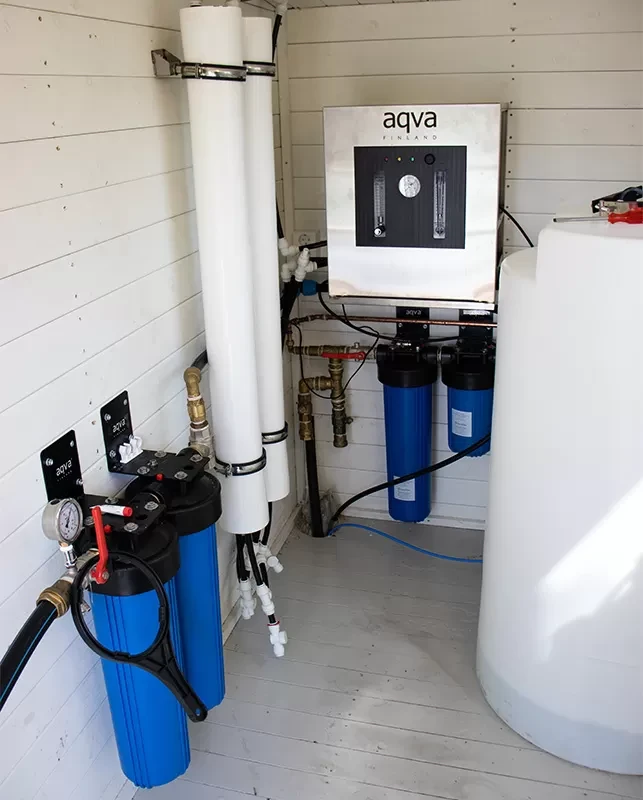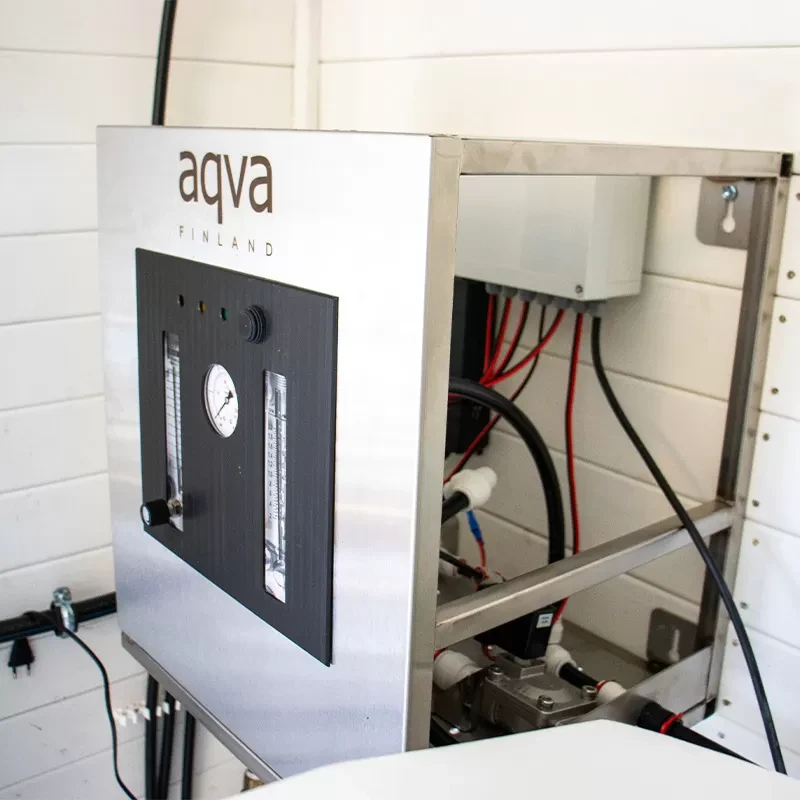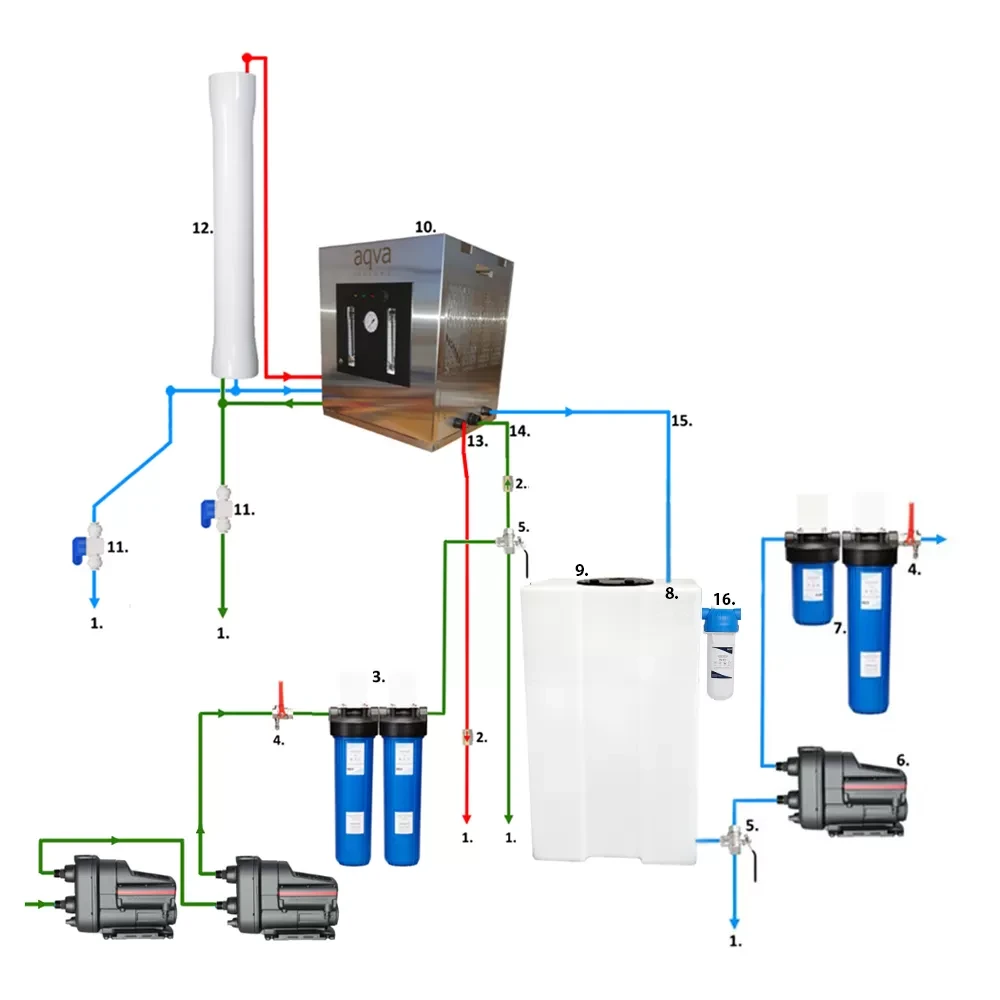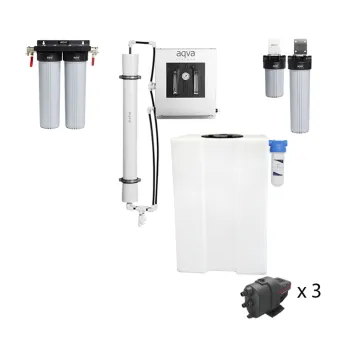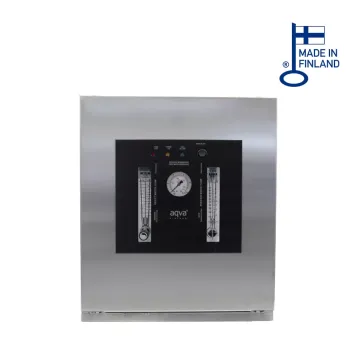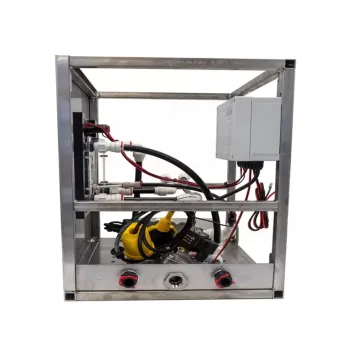AQ020-1-B
AQVA AHTI M Reverse Osmosis System – 185L Tank, 50-100 L/h Fresh Water Production from Seawater
4960,00 €Sis. alv 25.5%
5 pcs available immediately
Tilaa saapumisilmoitus sähköpostiisi, niin saat heti tiedon kun tuotetta on jälleen saatavilla.
Testatusti toimiva
Toimitus 1-5 päivässä
14 päivän palautusoikeus
Kuvaus
AQVA AHTI M Seawater Reverse Osmosis System
The most efficient solution for purifying well or seawater into potable drinking water. Produces 50–100 liters of clean drinking water per hour.
Easy to install, commission, and use! Includes all necessary components, hoses, and parts. The package also includes a distribution pump, post-filters, and shut-off valves required for water consumption from the tank, but their installation and piping are not included, as these are part of the property’s own water system. The package contains a lift pump to draw water from the sea to the system and a pressure booster pump to increase feed water pressure for effective salt removal.
Benefits:
- Produces crystal-clear water.
- Finnish-made reverse osmosis unit, awarded the Key Flag symbol.
- The most reliable and user-friendly system on the market.
- Water production capacity can be expanded virtually indefinitely. Adding a second osmosis membrane doubles the system’s water output.
- Filters up to 99% of impurities.
- Superior salt removal with AQVA Baltic (AQ062-B) osmosis membranes, up to 97% even from warm water.
- Easy to use and maintain, even for seasonal cottage use.
- Easily meets the water consumption needs of an average Finnish household.
- Water is produced into a large 185-liter clean water tank, acting as a buffer during peak consumption.
- An automatic float valve in the water tank regulates the water level. When water is used, the water channel opens, and the pressure booster pump starts, keeping the tank full.
- Removes difficult-to-eliminate compounds such as fluoride, uranium, blue-green algae, chloride, and arsenic.
- Multi-stage pre- and post-filtration.
- Filters typically need replacement only once a year.
- Indicator lights, pressure gauge, and water flow meters provide essential information about the system’s operation.
- Water purification capacity at 8 bar feed pressure and 5 ppt salinity is approximately 50 liters per hour. (Typical salinity on Finland’s coastal areas ranges from 2–7 ppt, depending on location.)
Purification and Treatment Methods:
- XL-Sized Activated Carbon Filter: Removes solids and a wide range of impurities, including organic compounds, metals, industrial chemicals, and gaseous compounds like hydrogen sulfide and radon.
- XL-Sized Polyphosphate Filter: Protects the system and extends the lifespan of the osmosis membrane by converting impurities like limescale and organic matter into a form that prevents buildup in the system.
- Large Reverse Osmosis Membrane: The core of the system, it filters impurities highly effectively, allowing only clean water to pass through. Impurities are flushed away with the rinse water.
- Post-Filter: Ensures the hygienic quality of the water in and passing through the system with a combination of fibrous activated carbon and 0.1µm ultrafiltration, enhancing the removal of gaseous impurities.
- Post-Mineralization Filter: Adds calcium to the water and raises its pH, making it fresher and more natural-tasting.
Feed and Pressure Booster Pump Specifications:
- Two-stage pumping: The first pump lifts water from the sea, and the second increases pressure for reverse osmosis.
- Voltage: 230 VAC
- Nominal current: 4.8 A @ 8 bar
- Nominal power consumption: 1.09 kW
- Energy consumption for producing 100 liters of clean water from seawater is approximately 1 kWh*
- *Power consumption depends on water temperature, salinity, filter usage, and lift height from sea level to the system.
- Recommended operating pressure via the pressure booster pump: 7–9 bar. Pressure is adjustable via the seawater pump (Scala2) and the osmosis unit’s rinse water valve. Adjusting pressure achieves the desired clean water production rate, influenced by factors like salinity, water temperature, and filter usage.
- Salt removal efficiency with AQVA Baltic (AQ062-B) osmosis membranes: 95–97%. Affected by water temperature, membrane usage, and adjusted feed pressure.
Filters:
- Solid particles
- Turbidity and color
- Limescale
- Metals such as iron and manganese
- Heavy metals like lead, mercury, cadmium, and arsenic*
- Salts such as chloride, sodium, sulfates, nitrates, and nitrites
- Organic compounds like pesticides, pharmaceutical residues, and hormones
- Microbiological contaminants like bacteria, viruses, and molds
- Chlorine and other chlorine compounds
- Uranium
- Gaseous impurities like radon** and hydrogen sulfide
*Arsenic is typically filtered with over 85% efficiency, but performance may vary in some cases.
**If radon is present in the water, note that the activated carbon filter may act as a radiation source. More details are available in the installation and user manual.
Replacement Filters:
Annually Replaced Pre-Filters:
Replaced Every Two Years:
- Reverse Osmosis Membrane: AQ062-B
- Post-Mineralization Filter: AQPH-XL
- Post-Filter: AQUF01-L
- Air Replacement Filter: AQMF1-M
Replace filters at the latest if they become clogged or water production slows down.
Package Contents:
- Two XL-sized filter housings for pre-filters
- Pre-filters: AQCB-XL and AQPF-XL
- AQVA AHTI reverse osmosis unit
- Osmosis membrane: AQ062-B
- 185-liter clean water tank: AQ-TAN-185
- Tank air replacement filter: AQ1MC-MF1
- Feed water pump to draw water from the sea: Scala2
- Pressure booster pump to increase seawater pressure: Scala1
- Nearly silent distribution pump: Scala1
- Post-filter: AQUF01-L
- Post-mineralization filter: AQ1XL-PH
- Hoses and fittings for connecting pre-filters and the water tank to the reverse osmosis unit
Technical Specifications:
- Pre-filter inlet connection: 1" female thread
- Clean water tank outlet three-way valve: 3/4" female thread
- Distribution pump inlet and outlet connection: 1" male thread
- From post-mineralization filter to distribution: 1" female thread
- System requires approximately 200 x 150 cm of wall space. The largest single component is the water tank, with dimensions: H91 x L61 x D40 cm. Components can be freely positioned, and not all need to be in the same space.
- The system must be installed in a space where potential water leaks or drips on walls or floors do not cause issues.
- The system produces more rinse water than clean water. The recommended rinse water ratio is 2–3 liters per 1 liter of filtered water. This ratio can be adjusted using the rinse water meter in the system.
- Additional information is available in the user and installation manuals under the “Files” tab.
System Requirements:
- Stable feed pressure: 2–10 bar.
- Recommended feed water temperature: 4–30°C. Lower temperatures slow production but improve purification efficiency, while warmer water has the opposite effect.
Winter Storage:
- The system must not freeze with water inside. It can be used in locations without winter heating, but essential winter storage procedures must be followed. Detailed instructions are available in the system’s user and installation manuals.
Tiedostot
Arvostelut
Kysymyksiä
Tilaa uutiskirje

Haluatko ajankohtaista tietoa vedenpuhdistuksesta, tarjouksista ja uusista tuotteista? Käy tilaamassa inspiroiva uutiskirjeemme!



